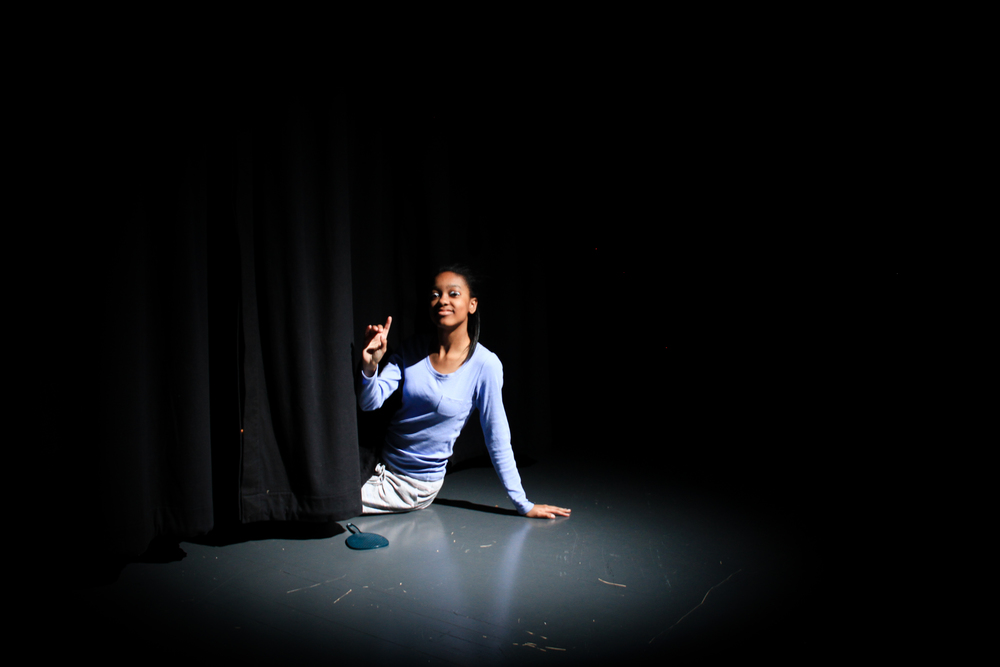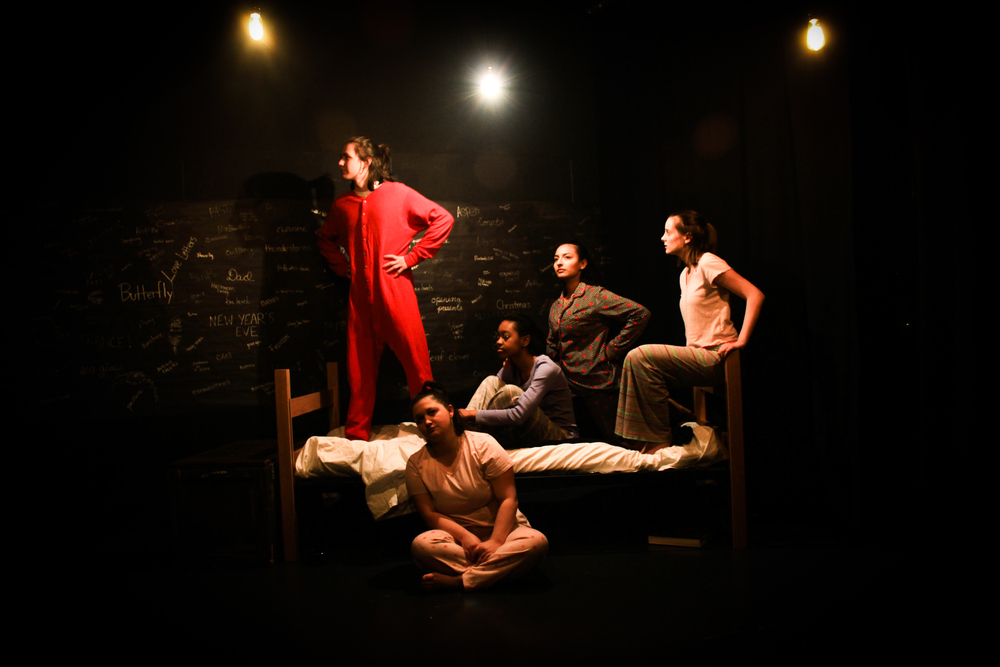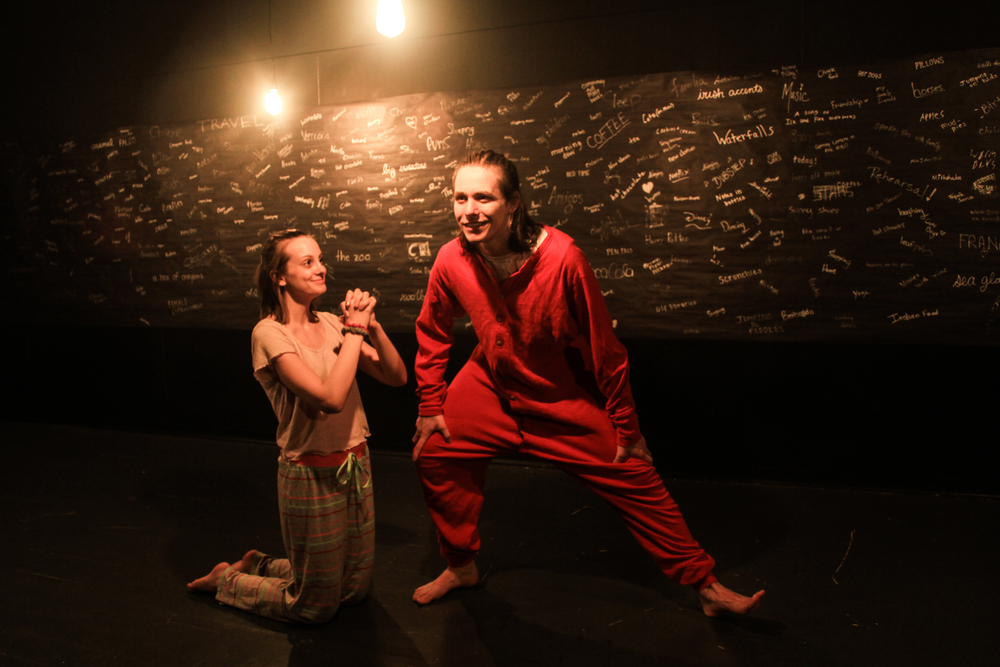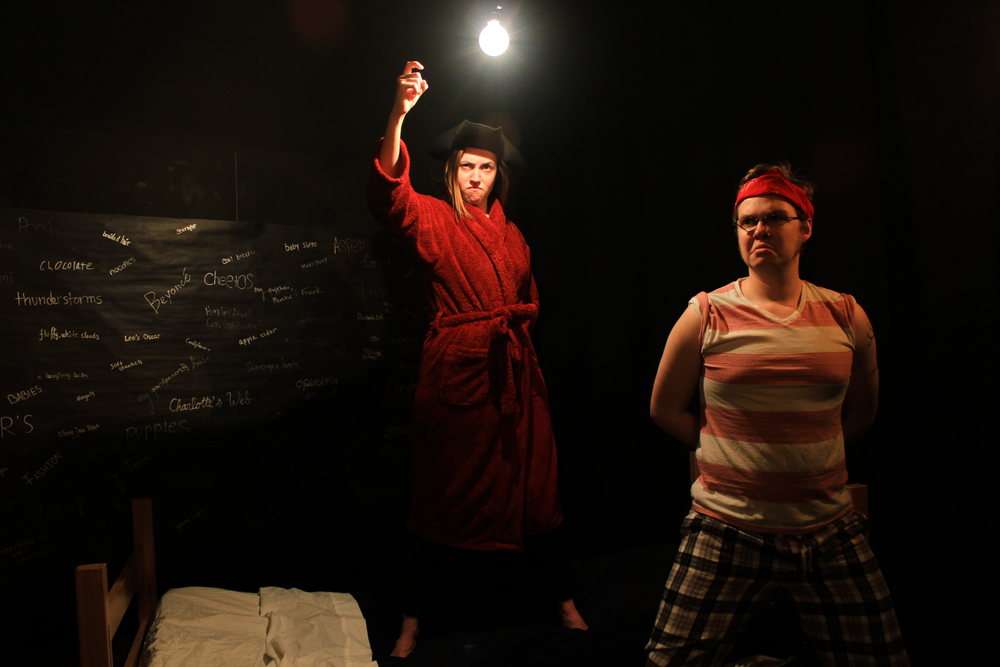
Kara Powell ’18 (Lost). Photo: Paris Baillie ’17
In Peter/Wendy, Imagination Runs Wild
By: Callum Lane ’16
“All children, except one, grow up.”
These words begin this wonderfully whimsical production of Jeremy Bloom’s Peter/Wendy, an adaptation of J.M. Barrie’s famous Peter Pan novels, directed here by Michael San Roman ‘17. This sentiment is sure to resonate with many. Who, as a child faced with the terrifying prospect of growing up, has not at some point dreamt of being the exception to this painful fact of life?
Images of childhood are present before the play even begins. Walking through a gateway of Christmas tree lights, the audience sees Wendy played with youthful effervescence by Sammy Bluth ’19 sitting on her bed in pajamas, reading Peter Pan. To her right is a large wall of “happy thoughts,” with words and phrases like “Vermont,” “Female Empowerment,” “Root Beer,” and a drawing of the “Cartoon Network” logo adorning its face. This is not to say that Peter/Wendy, nor Peter Pan itself, deals exclusively with childhood. This production brings about a veritable tsunami of memories and truths about how people play, act, learn, and view the world both as children and adults.

Jacques Phelps ’18 (Peter), Sierra Fritz ’17 (Tinkerbell), Kara Powell ’18 (Lost), Julianna Quiroz ’17 (Tiger Lily), and Sammy Bluth ’19 (Wendy). Photo: Paris Baillie ’17
Bloom’s adaptation is based mainly on Barrie’s novel Peter and Wendy, and Bloom’s choice to slightly alter the title for his play is a meaningful one. While the title of Barrie’s novel imagines Peter and Wendy as an inseparable team, Peter/Wendy implies a stark difference between the two–they are from different worlds, and thus can never be together in the way that they want. In this production, San Roman plays with the idea of Peter and Wendy as both a perfect pair and a contrasting one, to fascinating effect.
One example of this is through the juxtaposition of fantasy and reality. For instance, Becca Gracey ’18 and Tom Chandler ’16 switch from scene to scene between playful, humorous portrayals of Captain Hook and Smee, respectively, to the nostalgic emotional honesty of Mrs. and Mr. Darling, Wendy’s parents. While two actors playing such markedly different roles may seem a bit jarring, the production manages to make it feel completely natural. Similarly, the boundaries between Neverland and the real world are defined such that the audience always knows where the action is taking place, but not so much that the playful energy that permeates the play is stifled. Whatever the actors believe, the audience believes. If Peter (Jacques Phelps ’18) thinks he can bring Tinkerbell (Sierra Fritz ’17) back to life simply by encouraging us to think happy thoughts, the audience does not question his logic. Watching this production feels like reliving long-forgotten childhood memories, when believing that you could fly would give you wings.

Sammy Bluth ’19 (Wendy) and Jacques Phelps ’18 (Peter). Photo: Paris Baillie ’17
Additionally, this production explores themes of lightness and darkness, particularly in the character of Lost (Kara Powell ’18), based on the “Lost Boys” from the original books. Powell spends the majority of the show with her eyes closed, with a frightening set of eyes painted over her eyelids—both literally and figuratively in the dark. There is also a moment in the play in which Tiger Lily (Julianna Quiroz ’17) implores the audience to close their eyes and imagine Neverland, allowing the audience the opportunity to create our own worlds, just as the characters in the play do. The idea of light and dark is also manifested in the lighting, designed by Chloe Brush ’18. Most of the stage is lit by numerous light bulbs suspended from the ceiling, which give the feeling of a being at a slumber party in a friend’s basement, way past everyone’s bedtime.

Becca Gracey ’18 (Hook) and Tom Chandler ’16 (Smee). Photo: Paris Baillie ’17
San Roman begins his director’s note with four simple, yet profound words: “Growing up is hard.” While it is easy to accept this as fact, finding the beauty in that struggle and allowing one’s inner child to shine through is a lot more difficult– and this production of Peter/Wendy is successful in both respects.
Overall, imagination is key. Much like Peter and Wendy, our adult and child selves seem to inhabit completely different worlds, yet through imagination—and perhaps a dash of pixie dust—they can be brought back together again.
***
Callum Lane is a senior Theater/Mathematics double major and a staff writer for the Living Newsletter.
Production Photos
Reflections from the Cast + Crew
Kara Powell ’18 (Lost): I really enjoyed working on Peter/Wendy, because it felt like playing. We got into such a childlike state of mind during rehearsal. We played games and Michael encouraged us to have fun, which I think is at the heart of the play. Fun is an essential part of growing up, and I think that it’s one of the reasons Peter Pan is such a universally loved story. I used to think that Peter was really cool, but looking back on it now, he’s kind of horrible, even if he is a child. Even still, I think people will continue to love Peter Pan because everyone is still a child at heart.
Sammy Bluth ’19 (Wendy): Through the process I learned that Wendy and I are not all that different; she is eager to explore and be independent, but feels she has lost something significant upon leaving her nursery and parents. She experiences the responsibility of caring for others and the complexity of relationships. This process also forced us to think positively at all times, coming up with hundreds of happy thoughts to write on the wall and say during the show, which was a welcomed break from the chaotic and often stressful life of college students.
Michael San Roman ’17 (Director): Peter Pan was a movie I had watched when I was little, but other than that I didn’t know much about it at all. It wasn’t till I found this play that I went back and read J.M. Barrie’s work. The differences between the story I was familiar with and the original text helped show me how our understanding of things changes as we get older. I saw the person I am today, but also the person I was when I was five. I wanted to bring some of those childish elements into the room with me, knowing that it was a part of the way that I looked at and understood the story today.
Jacques Phelps ’18 (Peter): The process made me think about how childish Peter is. I had to figure out what elements of his character were childlike, and which were more grown up. To be honest I hadn’t seen peter pan in years, so the story was relatively new to me. Peter/Wendy showed me that youth is powerful, and that maybe we don’t have to grow up.
Production Credits
Written By: Jeremy Bloom
Directed By: Michael San Roman ’17
Production Team: Chloe Brush ’18 (Lighting Designer/Stage Manager), Madeleine Emmerick ’16 (Fight Choreographer), Sydney Tennant ’18 (Choreography Advisor)
Cast: Jacques Phelps ’18 (Peter), Sammy Bluth ’19 (Wendy), Becca Gracey ’18 (Hook/Mrs. Darling), Tom Chandler ’16 (Smee/Mr. Darling), Julianna Quiroz ’17 (Tiger Lily), Sierra Fritz ’17 (Tinkerbell), Kara Powell ’18 (Lost)











